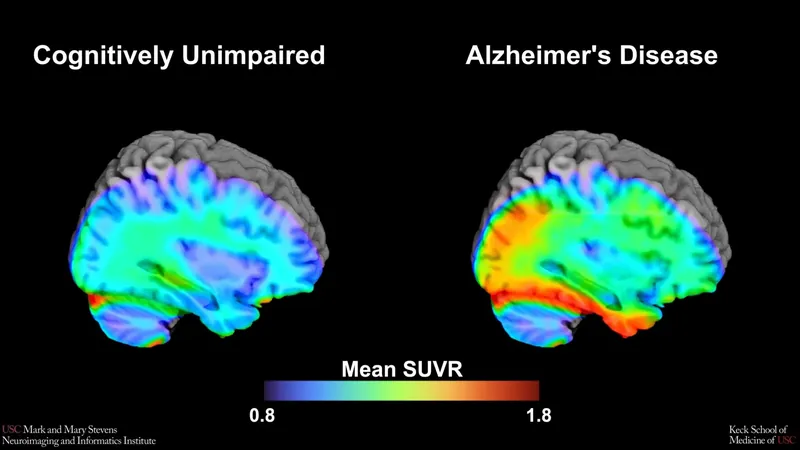
Revolutionary Brain Scan Could Unlock Alzheimer's Secrets—but Only for Some
2025-06-29
Author: Wei Ling
A Breakthrough in Alzheimer's Detection
A groundbreaking study using the advanced tau PET brain imaging technique has taken a significant step towards identifying Alzheimer's disease (AD) earlier in certain populations. Researchers analyzed data from over 675 older adults participating in the HABS-HD study, aiming to pinpoint the brain signals that differentiate those with early indicators of AD from those simply experiencing normal aging.
How Tau PET Works: The Science Behind the Scan
Tau PET scans utilize a specialized radioactive tracer to reveal abnormal tau proteins accumulating in the brain—key contributors to Alzheimer’s progression. By establishing tau cut-points, researchers can determine if certain levels of tau proteins in the brain warrant concern for early Alzheimer’s or related conditions. This novel benchmark opens the door to improved diagnostic interpretations for clinicians.
Findings: A Cut-Point with Limitations
The study identified a specific tau cut-point capable of distinguishing between cognitively impaired individuals and those without cognitive issues, but there was a catch. This method only proved effective in cases where another protein, amyloid, was also present, particularly among Hispanic and non-Hispanic White participants. Alarmingly, it failed to perform as effectively for non-Hispanic Black participants, suggesting other factors might be influencing cognitive decline in this group.
The Role of New Tracers in Alzheimer's Research
Using the innovative imaging tracer 18F-PI-2620, researchers measured tau protein accumulation in the brain, particularly in the medial temporal lobe—a crucial area associated with memory functions. They found that exceeding a specific tau level in this brain region indicated stronger links to cognitive impairment.
The Need for Inclusive Alzheimer’s Research
While the study supports previous findings associating tau in the medial temporal lobe with cognitive decline, its limited reliability among diverse racial groups emphasizes the critical necessity for inclusive research. Lead author Victoria R. Tennant highlights the urgency for studies that explore both biological and social factors affecting Alzheimer’s across different demographics.
A New Focus Towards Personalized Care
The outcomes of this research underscore the importance of refining diagnostic tools to be effective for a wider population rather than just a select few. Alzheimer’s disease typically evolves through stages, where tau tangles create closer links to memory loss, contrasting with earlier amyloid plaque formations.
Arthur W. Toga, director of the Stevens INI, praises the potential of these imaging techniques to improve our understanding of Alzheimer’s risk and development, as the HABS-HD study continues to uncover vital variations in ethnic responses to AD biomarkers.
The Path Forward in Alzheimer's Research
Ultimately, the hope is that these findings will foster more personalized treatment options and enhance care for all communities affected by Alzheimer’s. The research indicates that a tailored approach could be crucial in combating a disease that touches millions.





 Brasil (PT)
Brasil (PT)
 Canada (EN)
Canada (EN)
 Chile (ES)
Chile (ES)
 Česko (CS)
Česko (CS)
 대한민국 (KO)
대한민국 (KO)
 España (ES)
España (ES)
 France (FR)
France (FR)
 Hong Kong (EN)
Hong Kong (EN)
 Italia (IT)
Italia (IT)
 日本 (JA)
日本 (JA)
 Magyarország (HU)
Magyarország (HU)
 Norge (NO)
Norge (NO)
 Polska (PL)
Polska (PL)
 Schweiz (DE)
Schweiz (DE)
 Singapore (EN)
Singapore (EN)
 Sverige (SV)
Sverige (SV)
 Suomi (FI)
Suomi (FI)
 Türkiye (TR)
Türkiye (TR)
 الإمارات العربية المتحدة (AR)
الإمارات العربية المتحدة (AR)